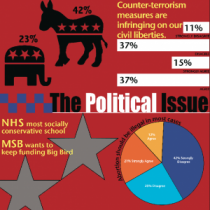For the past week or so, I have been sharing my apartment with a skinny, hairy, uninvited guest—a mouse, who pops in and out through a hole in the wall. He is small, and relatively harmless, so I didn’t mind lending him my living room for a few hours of the night. I let him run around and get his exercise in the comfort and safety of my home. But when he decided to permanently inhabit my favorite study corner, I realized that he had far outstayed his welcome.
One morning, as he sat innocently beneath my study chair, I prepared to attack. The closer I got, the faster my heart beat; as he saw me approaching, his little heart began to pump as well. I was ready to fight, but the mouse’s body was preparing him for flight—he dashed right back into the hole in the wall, faster than he ever had before.
This survival instinct was all a result of a hormone called epinephrine, or more commonly, adrenaline, secreted by a set of star-shaped glands that sit on top of the kidneys. This is the hormone that’s responsible for the feeling that you experience the night before taking the LSAT, or during the half hour you spend in the waiting room before your job interview.
When an animal, or a human, perceives a threat, the brain sends a signal to the glands, telling them to send epinephrine into the bloodstream. Once the body’s cells have gotten the message, they can collectively scream out commands to other areas of the body. They push your heart to beat faster and with greater force, they coax your liver into releasing more sugar and providing more energy, and they suck blood away from your skin and towards your heart.
Ultimately, epinephrine temporarily makes the skin pale, the mind alert, and the body strong.
Back in the day, when primitive man had to fight off grizzly bears, or attack wild animals for food, epinephrine was a vital asset. Increased energy output allowed for increased physical performance and better chances of survival.
For most of us, though, perceived threats come in the form of preparing for upcoming exams, giving a presentation, or interviewing and applying for jobs and graduate schools, all of which are rather sedentary activities.
Despite the natural build up in energy due to the flow of adrenaline, it is socially unacceptable to dispense that energy in day-to-day surroundings. No one gets up and does a set of jumping jacks after completing a particularly difficult exam problem, or asks to jog around the perimeter of the room while responding to a tough interview question. Civilized man has become good at holding things in. For most of us, adrenaline just keeps building up, and bouncing off the interior walls of our bodies, waiting to be dissipated.
What’s the best way to get it all out? Exercise. We spend too much time sitting around and thinking, and not enough time getting out and playing.
I myself am fairly unenthusiastic when it comes to exercise. I go for long walks instead of long runs, and though I always take the stairs no matter how high the climb, I don’t always enjoy it. But exercise isn’t really a choice, and it doesn’t really have to be painful. Snowball fights and chasing after Frisbees count. It’s a biological obligation, an unyielding demand. Even my furry friend, who darts around the living-room all night, knows the necessity of a good workout.
So when that daunting paper assignment hits the table, it’s time to hit the gym.
Get Sadaf’s epinephrine flowing and her heart pumping at squreshi@georgetownvoice.com.


